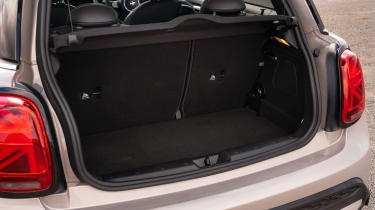MINI hatchback review - Practicality, comfort and boot space
The five-door model adds useful extra space, but the MINI hatchback is not a car bought for practicality

The new MINI is longer and wider than before, but the three-door feels barely any bigger inside. At least the front chairs tilt and slide forward to aid access, and up front there is plenty of space, with impressive headroom and improved shoulder room.
That means that while adults of most sizes will find a comfortable driving position, the trade-off when a taller person is driving (or is a passenger) is virtually nonexistent rear legroom
There are two gloveboxes (albeit the upper one is very small indeed), while nets on the seat backs and front passenger footwell give useful additional storage. The MINI still comes with a central armrest that can hide a mobile phone, but never fails to be in the way of your elbow, whether you have it up or down, and also obscures the iDrive controller between the seats.
Overall comfort is good in the MINI – though the seats themselves are on the smaller side, and combined with the MINI’s firm ride quality at lower speeds, it can feel harsh. The five-door model settles down well at a motorway cruise, however. Visibility is pretty good, despite the MINI’s letterbox windscreen.
Size
The MINI’s apparent growth isn’t just a trick of design – in every direction the third generation car is bigger than its predecessor, which in turn was bigger than the 2001 model, which in turn dwarfed the 1959 original. In modern context, at 3.8m long, the three-door MINI is significantly longer and wider than a Volkswagen Up.
Used - available now

2023 Mercedes
AMG CLA 35
22,342 milesAutomaticPetrol2.0L
Cash £27,700
2023 Audi
e-tron Sportback
35,651 milesAutomaticElectric
Cash £31,200
2019 Mercedes
GLC
29,619 milesAutomaticDiesel2.1L
Cash £21,200
2022 Mercedes
A-Class Saloon
24,798 milesAutomaticPetrol1.3L
Cash £22,500The five-door even more so, naturally, measuring in at almost 2ft longer than the Volkswagen. That takes it out of the city car leagues of the original and firmly into modern supermini (Ford Fiesta etc.) territory.
Leg room, head room & passenger space
Up front it’s a much more comfortable tale in the MINI than in the back, regardless of how many doors there are. For a car small by definition, the space up front seems remarkable – a 7ft person would have adequate head- and legroom, largely on account of how low the seats are set – a benefit of the ‘go kart’ brief.
The three-door offers a very cramped rear section, but the five-door is another story – what a difference a few millimetres makes. There’s noticeably more rear legroom – and it makes all the difference when taller people are up front. It basically makes the rear seats useable in a circumstance where they simply wouldn’t be in the three-door MINI.
Boot
The boot space is better than ever, up 30 per cent over the last MINI’s to 211 litres. And the five-door’s is better still, with its 278-litre space measuring up well against rivals like the Ford Fiesta (290 litres).
A twin-floor boot is standard, which is useful in raising the loading level to the lip of the rear hatch, making loading and unloading easier – or for keeping items of luggage separate from one another. It nearly clips up onto the back of the rear seats when not in use, too.








